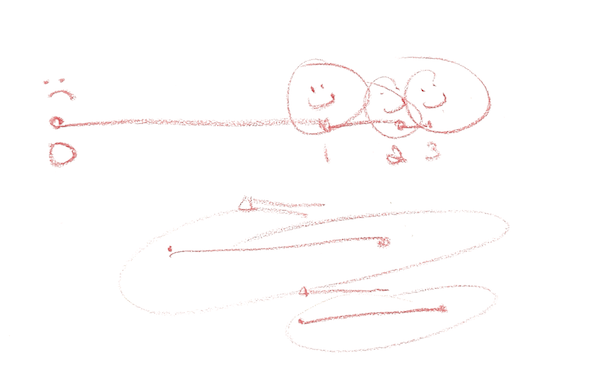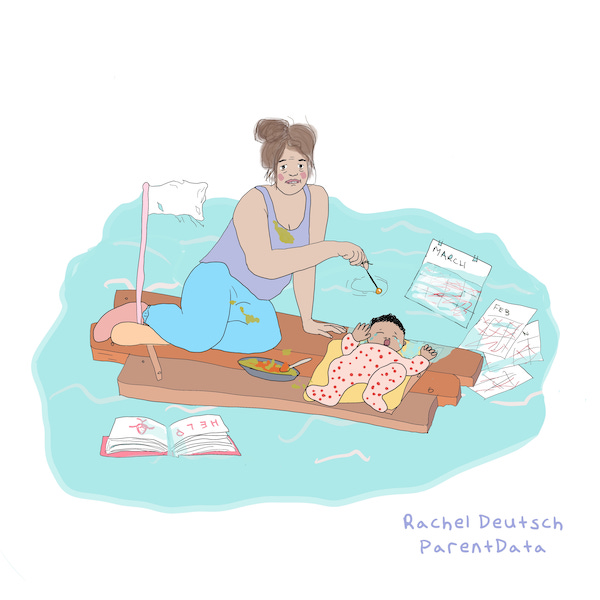Welcome back to Wins and Woes, a moment in the week when we step back from the data to share your stories about the ups and downs of pregnancy and parenting.
Today we have three stories, and a question from a reader who is desperately searching for solutions (and support) for her unsoothable child.
Economics 101
Every night, my 3-year-old goes to the fruit stand on our corner, where they give him Andes chocolates — let’s just say he’s charmed the neighborhood (and he does pay sometimes; he tried to buy 10 with $20 the other day). When we got home last night, he got very upset that I wouldn’t let him have all three. I sat down and drew him a happiness chart demonstrating how happy each chocolate would make him and how he would get less happiness from each chocolate if he ate them all at once. When I finished, he asked me to draw circles around the happy faces and then agreed to only have one and save the others. Economics 101 for the win!

[Emily’s note: What is being illustrated here is that having one makes you much happier than zero, but two is only a bit better than one (and so on). This is the lesson of “diminishing marginal returns.”]
Twins and a Toddler
As a mom of 4.5-month-old twins and a 2.5-year-old, I hear “bad mom” in my head more than I would like. There isn’t enough mom to go around. I recently realized my negative self-talk was a problem when my mom spent the week here and I heard her negative self-talk over and over. I realized that her voice became my voice. But I don’t want my voice to become my kids’ voice.
My biggest struggle lately has been with feeding. The twins are exclusively breastfed, but for the past couple weeks, I haven’t pumped as much as they are eating while I’m at work. Logically I know that to exclusively breastfeed twins for 4.5 months is a huge win, but I am my own biggest critic and can’t help but feel like a bad mom because my body is failing my babies.
Moms Supporting Moms (with Sushi)
Recently, a friend who is pregnant for the first time shared how much of a game-changer it was to have seen me eating sushi when I was pregnant. She’s a physician, and never knew what the causal literature (or lack thereof) suggested. It meant more than I expected to have unknowingly led by example for another soon-to-be mom, and I’m excited to have a community where we lift each other up, even with something as small as sushi.
This week’s reader question

Our 13-month-old came out of the womb screaming, and it feels like he has barely taken a breath since. The “colic” did not subside at six weeks, or 12, or even a year, when everyone said it would. We have had bouts of reprieve, but on the whole, our baby is extremely strong-willed and seems susceptible to what we would describe as panic attacks and working himself into an oblivion that he cannot soothe himself or be soothed out of (e.g. crying fits that last 3+ hours).
It feels like we have tried everything — probiotics, dietary changes, different formulas, solid food, craniosacral therapy, dermatologists, sleep training, gas drops, gripe water, different pediatricians, countless pediatrician visits, ER visits (stomach ultrasound revealed nothing sinister, likely gas), antidepressants (for Mom), therapy (for Mom). I have tried getting an early intervention appointment in case they could tell us something about our baby (to no avail, no referral). I just spent the morning googling alternative/shamanic healers in my area because I don’t know what else to do.
He presents as healthy, hitting his developmental milestones, and every time we go to the doctor he is of course fine and smiling. Thank goodness he is “healthy,” but it affords us zero help and makes me feel even more isolated. My partner and I are going crazy. It feels like we are on an island because we can’t quite describe the special hell the last year-plus has been to our friends with similar-age kids who all are seemingly happy and thriving. Can anyone relate? Does our baby just hate us? Does anyone have any suggestions? It devastates me to say this, but I’m at the point where I feel like someone else can do this better than we can.
—Desperately Seeking Solutions
Community Guidelines















Log in